1970 El Camino SS396 & SS454
Any comments/corrections/additions please send
them to me and be sure to specify which year.
![]()
The 1970 model year added a second SS option, RPO Z15 for the SS454, and both the Z15 (SS454)and Z25 (SS396) still remained an option on any V8 Custom El Camino.
The only way to truly document a 1970 El Camino as having the SS396 or SS454 option is with some sort of paperwork showing the option itself or the engine suffix code and the car's VIN. Examples would be the build sheet, warranty card protect-o-plate showing a 396 or 454 engine suffix, or an original factory stamped engine where the partial VIN stamping is a match to the car's VIN.
There is a bit of engine confusion for 1970. The venerable 396 received a +.030 bore to bring it to 402 cubic inches. Chevrolet was already heavily invested in the SS396 mystique so this slightly larger engine was still referred to as a "396." Why the 396 was bored to 402 isn't exactly known although there are plenty of thoughts on the subject. The one I would conform to is there were different emissions regulations for engines over 400 cubic inches than there were for engines under 400 cubic inches and this was an easy way out for Chevrolet without having to design a new Mark-IV engine and still have two engine sizes for SS El Caminos.
To compound the matter a bit more, a second 402 cubic inch engine was introduced under the regular production option code of RPO LS3. Essentially the same engine as the L34 available in the SS396 but with no chrome trim (valve covers, air cleaner, etc.) and a slightly less horsepower rating of 330hp. The LS3 engine was available in any series and body style available in 1970 except an SS-optioned V8 Malibu series Chevelle.
If you're not already confused with the LS3 402 cubic inch engine, Chevrolet also introduced a 400 cubic inch small block engine (RPO LF6) for full size cars and the Monte Carlo. Chevrolet continued to call the L34/402 a "396" and they called the LS3/402 a "400-4" while they called the small block 400 engine a "400-2." The "-4" and "-2" referred to the carburetor for each engine; the LS3 got a 4-barrel while the LF6 (RPO LF6) received only a 2-barrel. The LS3 engine will become important in 1971 & 1972 as well.
The 1970 RPO Z25 SS396 option included the L34 396/350hp engine with the L78/375hp engine available until GM cancelled the L78 engine on October 30 of 1969 with the announced release of the LS6/450hp version of the 454 engine. Part of GM's letter states, "In conjunction with the release of LS6 450-hp engine, the 375-hp Engine Option L78 and the L78/L89 for use with SS 396 is in process of being cancelled, and further orders for these options should not be submitted." The L78 engine cars already in the pipeline were allowed to proceed until L78 engine stocks at plants were depleted. If there were no more L78 engines to complete orders, those orders were returned to the dealer and customers had to make a different engine choice. See my LS6 Registry site at http://ls6registry.com/tech/trivia.htm for more details of the cancellation of the L78 engine and release of both the LS5/360hp and LS6/450hp 454 engines.
Contrary to popular belief bucket seats and/or gauges were not standard equipment. A front bench seat, no gauges (except speedometer and fuel gauge) were standard with the RPO Z25 SS396 option and the Z25 option required either the Muncie M20/M21 4-speed manual or M40 TH400 3-speed automatic. The RPO Z15 SS454 still did not come with bucket seats or gauges but it did mandate either the optional M22 Muncie 4-speed manual or a heavy duty M40 TH400 3-speed automatic.
The RPO Z25 SS396 option included the 350hp, Turbo-Jet 396 V8, dual exhaust, special domed hood, black-accented grille, power disc brakes, sport wheels, wide-oval white lettered tires, wheel opening moldings, black resilient rear bumper panel, bright engine accents, and special chassis features. The SS396 option added $445.55 to the base price of the Malibu. Also required with the SS396 option was either the Muncie M20/M21 4-speed transmission at $184.80 or the M40 TH400 3-speed automatic at $221.80; in total the SS396 option added $630.35 ($445.55+$184.80) or $667.35 ($445.55+$221.80).
The RPO Z15 SS454 option included the same basic equipment as the RPO Z25 SS396 option with the primary exception of the engine where the 350hp 396 was replaced with the 360hp 454. The SS454 option added $503.45 to the base price of the V8 Malibu. Also required with the SS454 option was either the Muncie M22 4-speed transmission at $221.80 or the M40 TH400 3-speed automatic at $221.80; in total the SS454 option added $725.25 ($503.45+$221.80).
All SS396- and SS454-optioned El Caminos came with a 12-bolt rear end but Positraction was still an option; an open rear end was standard. However, a 12-bolt rear end, as well as Positraction, was available on non-SS396- and non-SS454-optioned El Caminos as well so the presence of a 12-bolt (with or without Positraction) is not an indication of a 1970 SS396- or SS454-optioned El Camino.
Both the SS396 and SS454 got the same SS grille emblem but the front fender emblems did distinguish between "SS 396" and "SS 454" and the Custom El Camino also sported "SS 396" or "SS 454" on the tailgate as appropriate. The sport coupe and convertible had an "SS" logo on the rear bumper pad. A bi-product of the rear bumper pad was no rear bumper guards were possible on either SS option due to the pad.
Both SS options also included a different dash than their non-SS counterparts. Round gauge pods housing the fuel gauge and speedometer replaced the sweep design of non-SS El Caminos. A word of caution here though, any V8 Malibu coupe, convertible, or El Camino could still order RPO U14 Instrument Panel gauges and get the same round gauge pod dash but it would include a tachometer, (moved) fuel gauge, speedometer, amp and water temperature gauges. So, a base SS-optioned Malibu would have the round gauge pods but no tachometer, no amp and no water temperature gauges unless RPO U14 was ordered in which case it got the same gauges.
It's uncertain if the clock was part of RPO U14 Instrument Panel gauges or not. Available GM documentation says the clock was part of RPO U14 but I've seen several gauge optioned SS cars without the clock and, to my knowledge, there was no listed option/choice to delete the clock from the package or why anyone would want to is open to speculation. The clock was also available separately under RPO U35 on both SS and non-SS optioned El Caminos.
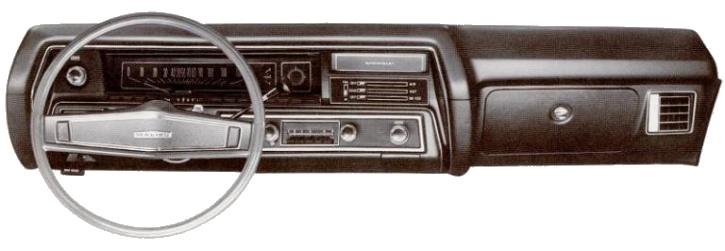
Base and Malibu series El Camino dash with 'sweep' speedometer.

Base SS (396 or 454) dash with round gauge pods for fuel and speedometer.
Note warning lamps for GEN (upper left), TEMP (upper right) and OIL
(lower right).

Another base SS dash with optional clock, no tachometer or gauges.
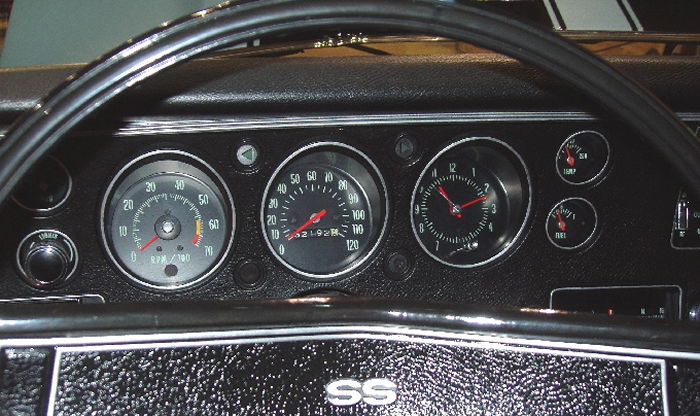
SS or Malibu dash with optional RPO U14 Instrument Panel gauges. Not
shown is the amp gauge that has been moved to the upper left opening
replacing the GEN lamp. The TEMP gauge replaces the TEMP lamp in the
upper right opening and the fuel gauge is located in the old OIL lamp
opening. The oil warning lamp is now moved to the lower center of the
tachometer. This dash is from an LS6 as noted by the redline on the
tachometer although an L78-optioned El Camino will have the same redline
tachometer when gauges are ordered.
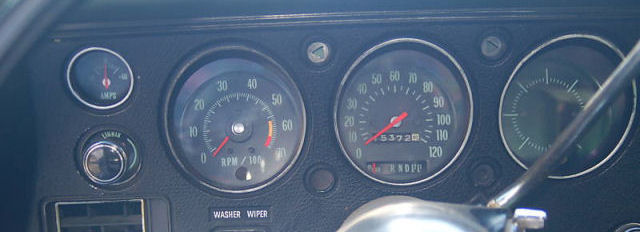
This example shows the AMPS gauge location but note there is no clock
which is reported to be part of RPO U14 Instrument Panel gauge option.
The tachometer redline might also give you some indication of which
engine was installed. All 3 have the same range, 0-7000, but the redline
differs depending on engine (and plant it has been discovered).
1. The 307 and two 350 engines tachometers redline at 5000 RPM.
2. The base 396 and 454 engines tachometers redline at 5500 RPM. *
3. The high performance 396 (L78) and 454 (LS6) redline at 6000 RPM.
* To date, all documentation shows that the Atlanta plant installed
the 5000 RPM redline tachometer in all base SS454 El Caminos. It is
assumed this was a computer programming error that generated the code
for the 5000 RPM tachometer instead of the 5500 RPM unit.
Original tachometers used three screws to mount the face. Note in the above examples the centered screw just above the needle center point and two lower screws above RPM and 100. An aftermarket tachometer has two mounting screws at "10" and "60" RPM numbers. Also note the silver outlining of the four smaller circle pods for turn indicators, brake, and high beam warning lamps. These are added by the owner and not something original dash faces had. It has been reported that many aftermarket suppliers of 1970 gauge dash panels also use silver on these four items.
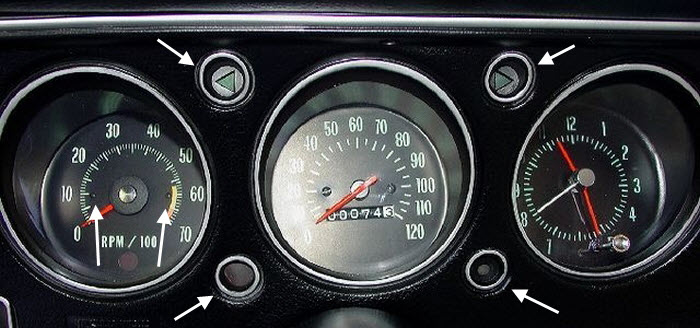
RPO D88 Hood & Deck Stripes. Some misconception with this option. RPO D88 was available on any Malibu coupe, convertible, and El Camino whether either SS option was ordered or not. To refer to an SS396 or SS454 optioned Malibu as "stripe delete" is incorrect - just as it'd be incorrect to refer to any El Camino without power steering as "power steering delete." RPO D88 was an option, therefore it couldn't be "deleted" if it wasn't ordered or part of another option package. Naturally when the D88 option (or ZL2) was ordered on the Custom El Camino, stripes were only applied to the hood. Stripe color was dependent on the color of the top, not the interior color. See Exterior-Interior Combinations/Seat Belts/Stripe Colors for more details.
This brings us to RPO ZL2, the cowl induction hood option. D88 Hood & Deck Stripes were part of this option package. Therefore the stripes could be deleted on request, and often times was. The third part of the ZL2 cowl induction hood package were the hood pins. Contrary to other reports, hood pins were only available with the ZL2 option package. Hood pins did not come standard on the SS domed hoods and did not carry a separate RPO number that would make them available to other 1970 El Caminos.
As mentioned before one of the items in both SS options was a domed hood. Some refer to this hood as a non-functional cowl hood but I disagree, it is a functional hood - it performs its function - and it's not a cowl induction hood. I'm sure what people refer to as 'non-functional' is in comparison to the optional RPO ZL2 cowl induction hood.
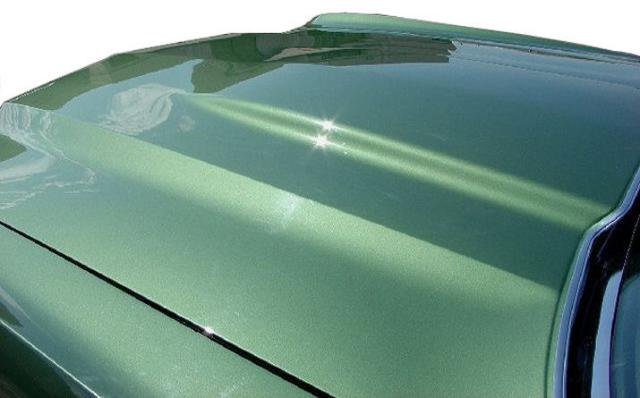
This is the domed hood the came standard on both SS396 and SS454 El
Caminos.
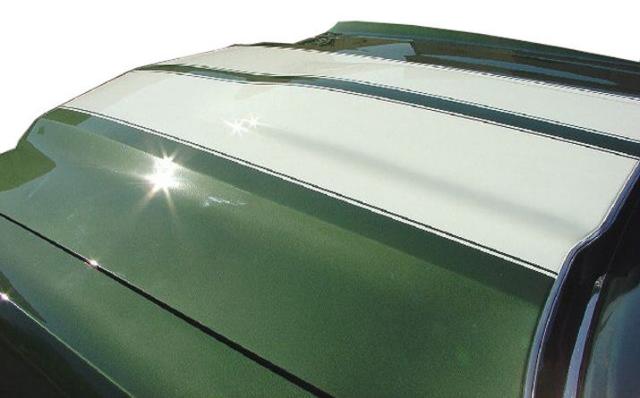
This is the same domed hood when RPO D88 Hood & Deck stripes were
ordered. Yes, the stripes were an option on both SS396 and SS454 El
Caminos. Since these were optional there is no such
thing as 'stripe delete' on a standard, domed hood.
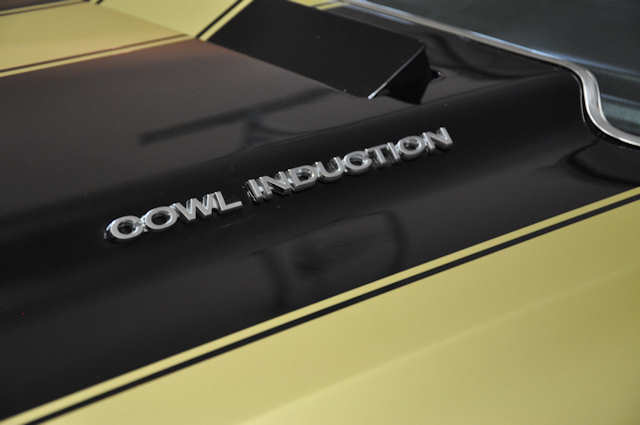
When RPO ZL2 was checked the standard domed hood was replaced with a
cowl induction hood that has a vacuum controlled 'flapper' that would
open when the engine was under throttle. Part of the ZL2 option was
the D88 Hood & Deck stripes. These could be deleted
when ordering the ZL2, unlike the mistaken notion they could be deleted
from the special domed hood when they were an option
on the domed hood (and the standard Malibu hood as well).
Early vs. Late 1970 Hood
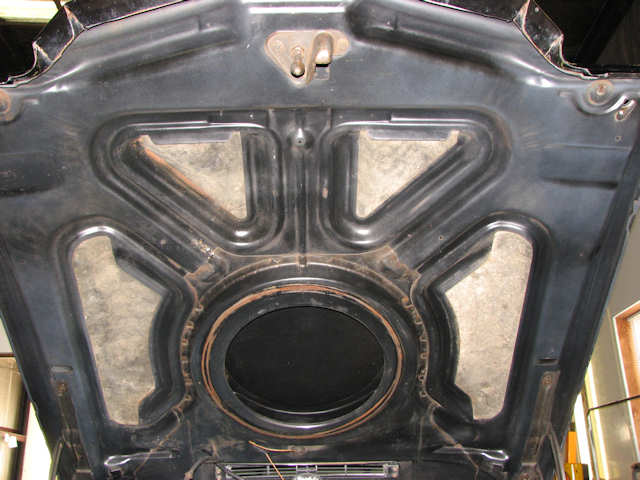
Photo Rick Nelson,
MuscleCar Restoration & Design.
Early version of the underside of RPO ZL2 Special Ducted Hood Air System
hood. The two openings on the front for insulation are smaller than
the later version. Note the cutouts have no "creases" for
a crush zone that the later version has.
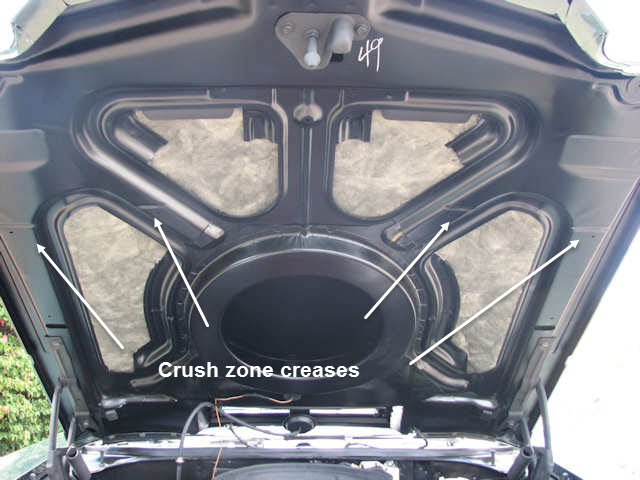
Late version of the underside of RPO ZL2 Special Ducted Hood Air System
hood. The two openings on the front for insulation are larger than the
early version. Note the cutouts have "creases" for a crush
zone that the early version did not have.
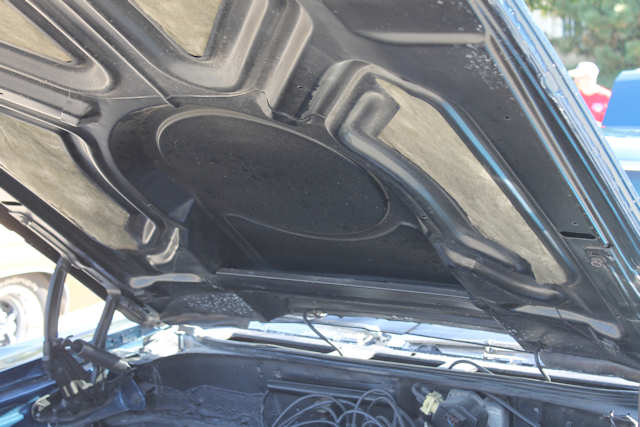
Early version of standard SS domed hood without crush zone creases.
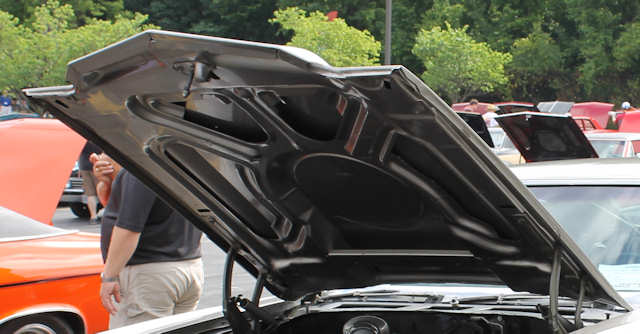
Late version of standard SS domed hood with crush zone creases.
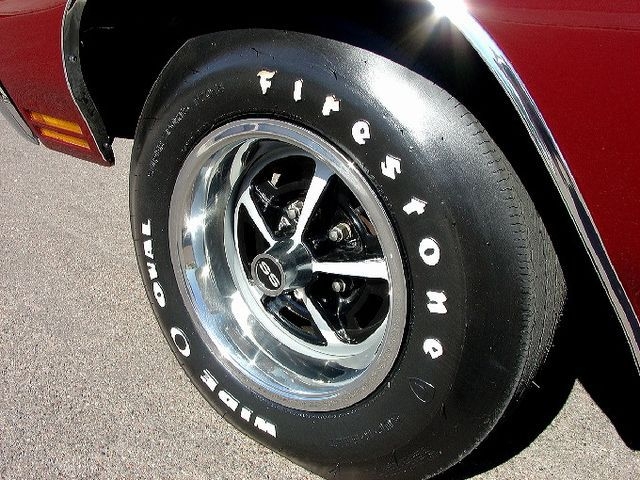
The special SS wheels were essentially the same as the 1969 SS396 wheels
and carried no RPO number so they were exclusive to the two SS options.
Although GM documentation shows the SS optioned El Caminos coming standard
with G70x14 tires, all of the 1970 El Camino build sheets I have from
Baltimore, Kansas City, and Van Nuys show RPO PX8 G60x14 white sidewall
tires through mid-March and F70x14 raised white letter tires after mid-March.
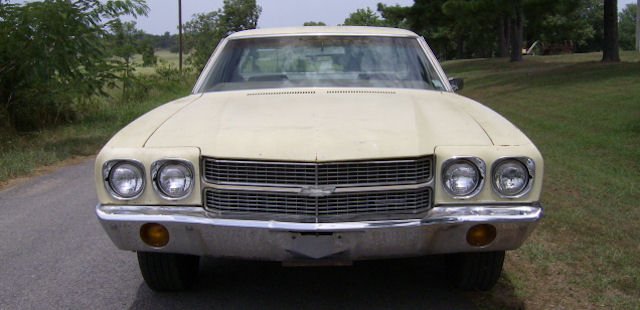
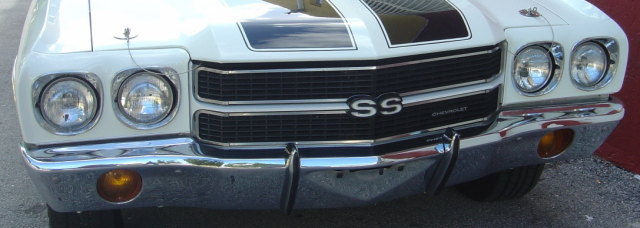
One El Camino difference from the other Malibus is the parking lamp
lenses were round instead of rectangular and all have amber lens
with clear bulb.


The SS-optioned El Camino tailgate has black painted area between the
two horizontal bright strips and were badged SS396 or SS454 as appropriate.
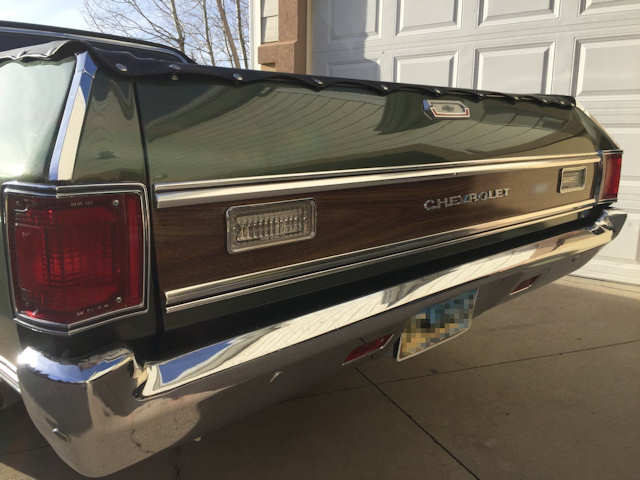
Compare the standard El Camino Custom tailgate to the SS-optioned one
above. Instead of the SS396 or SS454 emblem, a non-SS optioned El Camino
Custom has a 'CHEVROLET' nameplate.
Dash and RPO U14 Instrument Panel gauge information is the same for 1971 as it was in 1970.

A manual 3-speed was standar equipment on all 1970 Chevelles. Both SS
options required either a 4-speed manual or 3-speed Turbo Hydramatic
transmission.



